The Bull, the Stars, and the Axial Age of Transformation
Knowest thou the ordinances of heaven?
Canst thou set the dominion thereof in the Earth?
- Job: 38:33
Take a trip with me far back in time: to ice, and caves, and animal skins against the cold. The Sun dims, days grow shorter, trees and plants are dying, the berries gone. In a deep cave near a river hunters are gathered; a shaman chants, shaking and moaning, calling the spirits of animals that give life. The shaper dips his finger in charcoal-fat and makes a line, then another…a great aurochs sky-bull takes form, the stars in his head, the star-heap over his shoulder…the animals will come, they will give meat, and hides, and life.
Taurus, the great Bull-in-the-sky, is an extremely ancient figure; the magnificent Lascaux cave paintings, dating from the Magdelenian epoch (17,000 – 15,000 BCE) show him as an aurochs bull (now extinct) with the characteristic tilted “V” of stars in his head and the Pleiades Cluster over his shoulder; when they were created, he was an Autumn constellation, rising and setting with the weakening Sun. Over millennia as the great wheel turned, the Bull came to lead the signs, rising with the Sun at the Spring Equinox, from about 4300 to 1580 BCE. In the Euphratean Valley, cradle of our Western constellations, he was called “Bull-of-Heaven,” “Strong Wild-Bull” “Great-Horned Bull” and “Bull of the Foundation” (the tilted “V” of stars in his head is the source of the Phoenician letter “Aleph” – our “A”)1. Although he no longer leads the signs, his awesome power is central to our experience of, and profound connection to, the sky.
“The Great Transformation,” a new book by religious historian Karen Armstrong (inspired by psychiatrist-philosopher Karl Jaspers’ 1948 article, “The Axial Age in Human History”) postulates a span from about 800 to 200 BCE when cultures of four distinct regions of the world brought forth the great religious and philosophical traditions that have nurtured humanity to the present day. Jaspers wrote “the intellectual development that took place between 800 and 200 BCE, an epoch of extraordinary developments, was the most crucial turning point in history. Man became aware of his existence as a whole; consciousness and thought itself became an object of thought; spiritual battles arose; men strove to convince others by communication of ideas, reasons, experiences. Discussion, partisanship, the splitting of the intellectual sphere into antithetical tendencies closely related by their very opposition, produced unrest and spiritual chaos – in every sense, a step was made toward the universal. Hermits and wandering thinkers in China, ascetics in India, philosophers in Greece, prophets in Israel, all belong together, however much they may differ in faith, content, and inner orientation.” The axis, or turning point, of this transformation occurred in the 6th century (500’s) BCE, the century of Pythagoras, Xenophanes, Heraclitus, Parmenides and the “Seven Wise Men of Greece” (Thales, Pittacus, Bias, Solon, Cleobulus, Periander, Chilo), Hebrew prophets Jeremiah, Ezekiel and Daniel and the Israelite captives in Babylon who produced the first written books of the Talmud (Old Testament) from their ancient oral traditions; in India Siddartha Gautama (Buddha) founded Buddhism, Mahavira Jina, the first known rebel against the caste system, founded Jainism and the Upanishads were written; in the Far East K’ung Fu-tzu (Confucius) and Lao-tzu completely transformed Chinese philosophical thought.2
Jaspers, unaware, had chosen the time of a near-legendary (to us) and invisible (to them) conjunction of Uranus, Neptune and Pluto in the 6th century (500’s) BCE3 - could it be that this extraordinarily rare cosmic event influenced the human race to take a step out of its miasma of violence and chaos?
Conjunctions of Neptune and Pluto occur every 495 years, i.e. twice in a millenium, but a conjunction of all three outer planets, Uranus, Neptune and Pluto, are so rare that only two have occurred since 5400 BCE!4 Tracking these conjunctions (both of Neptune-Pluto and of Uranus-Neptune-Pluto) then adding precession adjustments to find out where in the sky they occurred (that is, at what fixed stars), an astonishing pattern emerged: in the 7,000 years from the triple conjunction of 5036 BCE5 to the most recent Neptune-Pluto get-together in 1891-92, every one of the 14 conjunctions of the outermost planets has occurred in the stars of the Bull!
What is there about this great, ancient sky-icon that makes it (apparently) a cosmic baseline for humanity?
The bull is a complex totem, paradoxically combining lunar earth-mother and solar sky-father principles. Because its horns replicate the curved lunar crescent, it is associated with the Moon and thus with the moist, feminine powers of nature, ardor, seduction and the procreative urge. On the other hand its fertility, raw strength, rampant sexual power, brute force and the vigor of animal desire sweeping all before it are images of the masculine-solar generative force. Horns, too, are dual symbols: they are penetrating, thus active and masculine, and “crown” the head, thus are kingly; yet when broken or cut (used as drinking vessels, for instance), they are receptacles, which are feminine. In ancient times, a bull’s bellow was associated with thunder and the rumble of earthquakes, and, by extension, with God’s great gifts of rain and fertility, his divine punishments of violent upheavals, and withal a communicating link between heaven and earth. Is this the message – a link with the divine?
The extraordinary “Axial Age” three-planet conclave of 577-576 BCE (the 1st in 4,459 years!) took place at the Bull’s horns; Uranus and Pluto were exactly aligned at 11 Taurus 036 and Neptune was 1° 49 minutes ahead of them, at 12 Taurus 52; with the precession adjustment of 35 degrees, 57 mins, these become, respectively (tropical) 17 Gemini 00 and 18 Gemini 49 (epoch 2000.0). The stars here are 98 Tauri (16 Gemini 01) in the North Horn, Iota Tauri (16 Gemini 47) between the Horns, and 104 Tauri (17 Gemini 32) in the South Horn. Aligned with these in longitude are, to the south, brilliant blue giant Rigel, Beta Orionis (16 Gemini 50), the 7th brightest star in the sky in the upraised left foot of Orion, the Great Hunter, and to the north of the Bull, double star Al Ma’az, Epsilon Aurigae (18 Gemini 50) a “mysterious” eclipsing binary in the burdened left arm of Auriga, the Charioteer (he carries a mother goat and her 2 kids); the brighter star of the binary pair, a supergiant, is 60,000 times more luminous than the Sun, and its “ghost” companion “may be the largest, coolest, most rarified star known.”7
In very ancient China (whose earliest sky figures go back as far as the Lascaux paintings!),8 this was the realm of their huge White Tiger of Autumn “who roared like the rumbling of thunder” (an interesting parallel with the tradition of the Bull’s thunderous bellow); thus we have, in the West, a dangerous, head-down, charging, bellowing Bull; in the East, a ferocious, roaring Tiger — hardly what you might expect for a flowering of religion and philosophy! Within the White Tiger were smaller figures: the distinctive V-shape of the stars in the Bull’s head was ancient China’s Py, a hunting-net used in the autumn round-up and slaughter of game, associated with attacks and punishments; the great figure of Orion, just below the Bull, was figured very much like our mighty hunter, but to the Chinese he was Tsan, the Supreme Commander, a trustworthy military leader with nearly absolute authority, charged with protecting villagers against wild tribes that attacked in the winter. In ancient India stars of the Bull’s head formed the nakshatra Rohini, ruled by creator God Prajapati (assigned by modern astrologers to Uranus) or by Brahma the Creator himself. The name Rohini has two derivations: ‘red’ or ‘to climb, rise, grow.’9 Rohini therefore is associated fertility, creativity, rising, growth and birth. It is the mansion of cows and other cattle, important on every level of Indian society; cows and buffaloes give dairy produce; their dung provides fuel and manure for the land, and oxen and buffalo are farmers’ draft animals (horses were reserved for the warrior aristocracy). An ox-cart and a temple share the mansion’s symbolism. In Hindu mythology the god Shiva (destroyer of evil) rides an ox, and Krishna, the incarnation of Vishnu, was a cowherd. At the Great Conjunction, Uranus and Pluto were in Rohini, but Neptune had edged into Mrgasiras; according to sanskrit scholar Valerie J Roebuck, the verb mrg-, formed from mrga, means ‘to hunt’ and ‘to search,’ ‘to ask for,’ From mrga comes marga, which means any path or road, with associations of going where others have gone before, and thus of tradition and custom. So here we have Orion, the Great Hunter (India’s tradition suggests that he hunts and searches not only for game, but for answers!), and the powerful, aggressive Bull. The combined influence of Uranus and Pluto (according to Ebertin) is transformation, revolution, the collapse of the old order of things and construction of the new; untiring effort and endurance (negatively, precipitous action, a mania of destruction); combined with Neptune, there is a sympathetic understanding of other people, knowledge of human nature, an inclination to delve into supernatural realms; Neptune with Pluto gives an intensified and purified soul life, love of mysticism, a high degree of sensitivity and “self-knowledge by the inner realization of truth.” For Uranus and Pluto with Neptune, Ludwig Rudolph has, simply, “a step into the unknown.”
1st-century CE Roman astrologer Manilius (a contemporary of Jesus and Emperor Augustus), wrote “the Bull, chieftain of the herd, with Venus for his guardian, rejoices in the plough, endowing honest farmers with a source of labor in their peaceable lives; it lowers its neck, insisting on a yoke for its shoulders, awakening unplanted land to cultivation…or he carries rods of public office…abandoning his plough to become a dictator. Those born under the Bull have a love of unassuming merit; they take strength from a massive size that moves slowly” But the stars in the Bull’s head (the Hyades cluster, including royal Aldebaran, and the horns (now about 4 to 29 Gemini) come in for a very different, sharper interpretation: those born under them do not enjoy tranquility; they crave crowds, mobs and civic upheavals; riots and rebellion make them happy; they provide fuel for fears, and long for brawls which overthrow peace.” Here is a distinct description of the dual nature of the Bull – either quiet, pastoral, servile and sacrificial, or restless, aggressive, rebellious and dictatorial! The alignments with Rigel (Orion) and Al Ma’az (Auriga) bring in themes of aggression and militarism (in ancient China stars of Auriga formed “The Five Chariots” – a military encampment) but also, betimes, protection of the helpless (Tsan is a protector against marauders; Auriga carries a mother goat and her kids).
Research has shown that people born under these stars are exceptionally gifted, perceptive, imaginative and original, with unique viewpoints and a wide range of talents, especially in art, literature and music. Religion, philosophy and finance are important to them; natural leaders and founders, commanding, charismatic, daring, pioneering, they are drawn to public life and activism, but if they fail in their ambitions, they may descend into infamy, becoming untrue to their own ideals. Dictatorial and opinionated, they feel compelled to act on their beliefs and seem to assume that there is a “divine right” underlying their impulses; their tendency to arrogance and self-righteousness can make relationships troublesome; they often rely on their intellect and excellent sense of humor to carry them through. There may be an involvement with children, and some become teachers and models for the next generation. Sensitivity and a willingness to listen to others are keys to success. Under harsh conditions there may be mental instability, sexual obsession, cruelty and/or a fascination with primitivism and the dark chasms of the mind. Major life issues include cruelty, coldness, aggression and indifference versus sensitivity, compassion and kindness; laxness and self-indulgence versus leadership and taking responsibility, and decisions about whether to fight or to make peace. In the mundane realm there are storms, explosions, stalking, sneak attacks, the arrogant or heedless use of violence, terrorism, massacres, epidemics, fires, animal attacks, natural disasters and mass deaths
Where, in all this, is there a clue to why these stars above all others have been “chosen” as it were, to carry a 3,945-year message10 to humankind? These are the dangerous, lowered horns of the rampaging Bull and the upraised left foot of the Hunter-Warrior, ready to come down in a cosmic stomp! Karen Armstrong’s remarkable research brings enlightenment: the religious-philosophical developments of the 6th Century BCE occurred in reaction to extreme violence! In each of the great empires of the time, a longing for peace, for relief from constant, unremitting wars, raids, destruction (and entrenched indifference to suffering) pulled priests, philosophers, scholars and common people as well towards a search for a better way, a path to peace and tranquility. Here, as well, are the stars of the concerned Charioteer, the Dove with an olive-branch in its beak, and above all, there is, at the conjunction, the powerfully-placed Venus, tutelary deity of the Bull.
CHART OF TRIPLE CONJ OF 577 BCE, SET FOR LUMBINI, NEPAL (BIRTHPLACE OF BUDDHA)
June 23, 577 BCE NS (June 29 OS), 8:20 PM GMT, Lumbini Park, Nepal, 27N28, 88E16
It is the Summer Solstice; the Sun, at the height of his heat and power, is in the Crab, home of nakshatra Pusya, “nourishment,” associated with prayer, speech and wisdom; its regent, Brhaspati, is the teacher-priest of the gods; Mercury, ruler of the 2nd of wealth and 6th of servants and military service (often enforced) is combust the Sun (nearly cazimi), blasted and blinded in his rays (or energized by them?). The Moon, in dignity, is actually at the Lion’s breast in nakshatra Magha, ‘The Great’ ‘Increasing’ ‘Bountiful,’ associated with brightness, majesty and power; this is the mansion of the Pitrs, ‘Fathers,’ maintained in heaven by offerings of their descendants; its symbol is a royal chamber containing a throne. Here at Lumbini the Great Conjunction is Rising, with Uranus caught in the tossing horns of the Bull (the precession adjustment to 2000 CE is +35° 57′); nearby Aldebaran, the Bull’s royal eye, co-rises. Venus, the Bull’s protector and guardian, dignified and exactly aligned with her own heliocentric NNode, escorts the three invisible outer planets, as if leading the way for them to follow; she lies at a cauldron of transformative energies and influences, just past the Bull’s horn-tips, in the “River of Heaven” (Milky Way) between Chi1 and Chi2 Orionis, at the tip of the Hunter/Warrior’s sword, aligned with Beta (Menkalinan) and Theta Aurigae in the Charioteer’s right shoulder and hand and, to the south, stars of Columba, the Dove; she is just entering nakshatra Ardra, “The Moist One,” whose symbol is a teardrop, ruled originally by Vedic storm-god Rudra, “the One who Weeps,” a fierce red form of Shiva who presides over destruction, procreation and transformation, suggesting that a calming, loving influence is approaching this difficult mansion.
At Lumbini, constellation Aquarius culminates (27 Capricorn 36 adjusts to <3 Pisces 33>) (Lahiri 9Aquar 42), showing the MC to be Sadalmelik, the Alpha star of the Water-Pourer, at his Urn-bearing right shoulder; the MC also aligns with royal star Fomalhaut, “guardian of the south.” These stars bring forth people dissatisfied with with the world and with themselves; longing for utopia, they dive deep into the waters of religion or philosophy, searching for ideas of ideal communities and ideal forms of human relationships; longing for peace, needing to feel safe, many become reclusive. Gifted loners, they enjoy experimenting, creating, inventing and problem-solving; whatever field they enter, they will work to discover new means of improving the human condition. Dramatic, excitable, powerfully, stubbornly fixed in their beliefs, they may suffer for them. Intuitive, often psychic, they are keenly aware of the cruelties, sufferings and weaknesses of humankind. Serenity does not come easily to them; they struggle with cynicism and pessimism, and deal with issues of idealism versus expedience, sexual moderation versus excess, religious belief versus atheism, prejudice and violence versus non-violence and pacifism. Jupiter, the most elevated planet, at 22 Aquar 34 <28 Pisces 31> (Lahiri 4 Pisces 40) squares Venus; he is “at home” in the sensitive West Fish of Pisces, aligned with Azelfafage, Pi1 Cygni in the soaring Swan, and is retrograding back to the flow of water from the Waterman’s Urn (this position of Jupiter, at the 23rd degree of Aquarius, will turn out to be important in happenings flowing from this event); Saturn, ruler of the 9th, 10th and 11th at Lumbini, lies just above Antares, the Scorpion’s royal and warlike heart, near shaman Ophiuchus’ left foot; retrograde and setting; at the Dsc at Lumbini, he may represent the constant warlike pressures that challenge the serenity and peace of the realm; his solstice point is 24 Aquarius 23, conjunct Jupiter. Alas, we have no reliable date for Buddha, but I chose Lumbini (his birthplace), because of all the major philosophical figures born in the 6th century BCE, in many ways he epitomizes the extraordinary developments of his time (it is interesting, in this regard, that the conjunction was Rising at his birthplace!) For possible chart of Buddha, see Notes in red at end.
For more than 25 centuries, major historical and philosophical advances and their leaders have tied into this ancient chart – warriors and peacemakers, the turbulent “upheavers” of history and the gentler souls who have raised humanity’s consciousness, from Alexander the Great to Gandhi, Tamerlane the Conqueror to Abraham Lincoln, have direct, exact links to this ancient Great Conjunction.
Confucius (K’ung Fu-tzu or Kongfuzi, “Great Master Kong”) was born Sept 28, 551 BCE OS11 just 26 years after the Great Conjunction (hereafter referred to as “577″). At his birthplace, Qufu, Shandong, the 577 Jupiter was in the 9th, exactly trine the Asc, which aligned with Canis Minor’s Alpha star Procyon (now 26 Cancer).-this figure, the Little Dog at the edge of the Milky Way, was called “The Guardian of the Crossing of the River of Heaven.” Confucius’ Jupiter (14 Taurus) was at the 577 Neptune; his NNode (23 Cancer) at the 577 Moon, his tight Mercury-Uranus cnj (square Pluto) right on the 577 Mars-Transpluto cnj, and trine the cnj itself. His Venus at 23 Libra trined the 577 22 Gemini Qufu Asc, and his Mars squared the 577 Sun-Mercury cnj. The 577 Qufu MC at 1 Pisces aligned with lunar mansion Tung Pi, the Eastern Wall, the “house of exalted virtue” (considered auspicious if one was respectful of ancestors and performed proper observances – a virtue dear to Master Kong’s heart!) In an age of increasing violence and cruelty, he worked doggedly and persistently to pursuade people to return to “The Way” of ancient Chinese virtues; it is said that he was the 1st to teach the Golden Rule: “What you do not want done to yourself, do not do to others.” 12
Athenian philosopher Socrates was born on “6th Thargelion in the 4th year of the 77th Olympiad” which comes out to June 1, 468 BCE OS13 Born when Pluto had reached an exact opposition to the 577 Venus, he had Mercury at the 577 Sun-Mercury conjunction, Venus at 15 Taurus conjunct the 577 Neptune at 13 Taurus, both squaring the 577 14 Aquarius/Leo Asc-Dsc angles at Athens; his NNode and Mars-SNode conj exactly squared the Great Conjunction and his Saturn sextiled its Venus. (It is interesting that the 577 Saturn at 6 Scorpio landed on the 9th house cusp at Athens, for the Greeks took the transformative impulse in a more scientific and political direction than other cultures). Socrates’ deep search for the nature of goodness and his devotion to truth made him no friends in the halls of power – Athens, untrue to its democratic ideals, was struggling, and failing, to maintain its empire – Socrates, made a scapegoat and condemned to death, accepted this fate with serenity, true to his belief that “we ought not to retaliate or render evil for evil to anyone, whatever evil we may have suffered from him.” 14
Did the 577 BCE conjunction’s spiritual influence last beyond its own century?
Edgar Cayce, under hypnosis, gave the birth date of Jesus as March 19, (the year given is not clear; 7 BCE is used, but 6 BCE is another possibility); (OS assumed, no time was given, 0 hour LAT used);15 the 577 Asc at Bethlehem was 3 Pisces, Jesus’ Uranus 3 Pisces (in stars of the West Fish); the 577 Bethlehem MC was 13 Sagittarius, Jesus’ Asc was 13 Sagittarius! Precession adjustment brings this to 19 Capricorn – Rho1 Sagittarii near the head of the Archer and strange, remarkable SS433 G Aquilae, an ancient supernova remnant in the wing of Aquila, the Eagle, which happens to be in the mysterious, rarely used intercalary nakshatra Abhijit (“Victorious”), ruled by Brahma, “under which the Gods conquered the Demons in battle.” These stars produce remarkable people with powerful, inventive, experimental intellects. His Mercury was square the (then) heliocentric Nodes of Venus, his NNode at 10 Taurus (at the Bull’s head) conjunct the 577 Uranus-Pluto conjunction, his Pluto is on the 577 Mars (8 Virgo), and his Moon-Neptune conj at 5 Scorpio is conjunct the 577 Saturn (6 Scorpio) If this is truly the chart of Jesus, there are remarkable connections to the Great Conjunction 570 years before his birth! Most remarkably, when a 28º precession correction to the present is added to the MC, it comes out at the great star Spica, Alpha Virginis, the brightest star in the Virgin!
Mohammed: (Feb 4, 575 CE, 3 PM LAT, Mecca)16 Mohammed’s Neptune was 20 Taurus, then the position of royal star Aldebaran, the Bull’s Eye; his 22 Taurus Moon was conj, and his Nodes square, the 577 Venus, his NNode at 23 Aquar 53 conjoined the 577 Jupiter (22 Aquar 34) and his Uranus at 11 Aquarius squared the 11 Taurus Uranus-Pluto of the Great Conjunction, but perhaps most startling is that the 577 NNode (20 Sagittarius) culminated at Mecca – and Mohammed, born 1,151 years later, had Saturn at 20 Sagittarius! Mohammed was confronted by angel Jibril (Gabriel) on Mt Hira in 610 CE and ordered to recite the words of Allah (this was the source of the Koran); since 610 was the year of a Great Mutation (once-every 20-year Jupiter-Saturn cnj), I ran a chart for the Great Mutation at Mt Hira17 – it was 24 Aquar 51, at his NNode and the 23 Aquarius Jupiter of 577! Remarkably, the Venus of the Great Mutation was the 577 Venus, with only a 5 minute orb! Reviled and persecuted for preaching the word of Allah, he and his followers were forced to flee for their lives: this was the Hejira (622 CE), Mohammed’s flight to Medina,18 the sunset chart has the 577 Moon descending, the 577 Saturn culminating, and Fortuna is 23 Aquarius, cnj the 577 Jupiter, Mohammed’s NNode, and the 610 Great Mutation.19
O sing unto the Lord a new song…
Make a joyful noise unto the Lord, all the Earth…
- Bible, Psalm 98
The aggressive head of the Bull brings upheaval, disorder, chaos, violence – when it reaches an unbearable extreme, there comes the instinct to balance, to restore the center…but without his force and ferocity, there would be no need, no instinct, no impulse, to seek a better way. There must be darkness before there can be light…each of these great philosopher-avatars (and others, not mentioned) were born into times of upheaval, disorder and violence (the aggressive, warlike side of the Bull and Orion) in each case, people were suffering the collapse of previous religious and cultural certainties; times were hard – greed, cruelty, selfishness and arrogance dominated their environment; peace was attainable only by the extremely wealthy (and even they were sometimes helpless). Out of these severe conditions, as if summoned by the suffering masses, came great souls who labored to find new paths, to “sing unto the Lord a new song,” and to pass on their wisdom for future generations, It is remarkable that each of the 6th century BCE forerunners, none of whom had knowledge of the others, taught the same essential message: abandon selfishness, develop compassion, treat others as you would wish to be treated; eschew violence; learn, love others and yourself, understand that all of us are not separate, but one.
These are still, after 2,582 years, radical, revolutionary ideals. We have a way to go.
Footnotes:
- 1. “Aleph means head, especially the head of the bull, Taurus…all letters begin with the sign Aleph, and descend from it”. Weinreb (1978: 65). http://www.uni-ulm.de/uni/intgruppen/memosys/cunni07.htm
2. Jaspers included Zoroaster (Zarathustra) whom he placed in the 6th century BCE, but recent scholarship makes the great Iranian prophet earlier, somewhere between 1,200 – 800 BCE, with 1,000 BCE as a rough estimate.
3. The three planets never exactly conjoined, but at their closest were only 1.8 degrees apart
4: the span of reasonably accurate astrological computing can only extend back that far – beyond that, the slight differences in source computations throw attempts at exactitude into turmoil.
5. In 5036 BCE, the closest they got was 5º25′ (this was 4,459 years before the 577 BCE gathering)
6: Exactly aligned in longitude; Uranus was at the ecliptic, Pluto 10º below it
7. Joe Rao, SPACE.com, Sept 13, 2002: http://space.com/spacewatch/extreme_objects_020913-1.html
8. Staal, Julius D W: Stars of Jade; Staal, an astronomer and constellation expert, precessed a planetarium back to discover when China’s 4 great “mother” constellations matched the seasons they originally embodied; the result was 15,600 BCE.
9. Valerie J Roebuck, Circle of Stars, p 105
10. The next (triple) conj of Uranus, Neptune and Pluto (and a new message?) will occur in 3369 CE (3,945 years after the last one!) – in the Pleiades, the famous cluster in the Bull.
11. date “traditional:” http://www.rightreading.com/daybook_pages/september-3.htm and is still celebrated in China
12. http://plato.stanford.edu/entries/confucius/. Tzu-kung asked, “Is there a single word which can be a guide to conduct throughout one’s life?” The Master said, “It is perhaps the word ’shu’. Do not impose upon others what you yourself do not desire.”
13. “Socrates was born in Athens in the fourth year of the 77th Olympiad on the 6th day of the month Thargelion, when the city is purified, according to Diogenes Laertius’ citation of Apollodorus’ Chronology.” http://gkonstantinou.homestead.com/socrates`ns4.html. Translating from the ancient Greek calendar is notoriously difficult – I am deeply indebted to Douglas Klovedal for his extensive research; he also chose a time, 4:20 PM LMT, which would put Socrates’ 399 BCE (death year) solar return Asc on the MC.
14. http://www.religioustolerance.org/reciproc.htm
15. Cayce reading #587-6, October 18, 1935; (the year he indicated is not decipherable in any known calendar – most scholars calculate it was very likely 7 BCE). (at 0 hour, Spica, Alpha Virginis, culminates!)
16. Date recorded by Al Biruni: “Monday, the Khur (11th) of the month Dai in the 41st year of Anushirwaf, at the beginning of the 7th hour, with the Sun in the liver of heaven and the Ascendant in Cancer” – from Rodden’s Astro-Data III, p 242 (but the date conversion given by Rodden was incorrect, as were the planetary positions). It is, of course, not possible to be certain that this is the correct date.
17. Great Mutation: Apr 5, 610 CE 0S, 9:27 AM UT, Mecca, 21N27, 39E49
18. They arrived at sunset: July 16, 622 CE OS, 6:28 PM LMT, Medina, 24N28, 39E37; this is the foundation date-and-time of the Islamic Calendar.
19. Osama Bin Laden’s MC is 24 Aquarius (Mar 10, 1957, 10:58 AM, Jeddah, Saudi Arabia; from Interpol’s Wanted site.
Note: the complex, long-range computations for this article could not have been managed without extensive, detailed help from Graham Dawson of Esoteric Technologies (Solar Fire) and Mark Pottenger (CCRS) – my heartfelt thanks to them both. Bernadette Brady’s extraordinary Starlight program provided visual backup and affirmation of the calculations.
6 29 577 BCE Uranian Transneptunian planets
Cupido 8 Cap 09 rx
Hades 23 Pis 16
Zeus 4 Cap 08 rx
Kronos 15 Gem 47
Apollon 2 Tau 28
Admetos 17 Pis 10 rx
Vulcanus 28 Leo 31
Poseidon 17 Tau 12
Transpluto 10 Vir 51
Bibliography:
Armstrong, Karen, The Great Transformation, Alfred A Knopf, New York/Toronto, 2006
Jaspers, Karl, The Axial Age of Human History, Commentary Vol 6, No. 5, November 1948
Roebuck, Valerie J., The Circle of Stars. Shaftesbury, Dorset & Rockport, Maine: Element Books, Ltd. 1992.
Staal, Julius D W, Stars of Jade, Writ Press, Decatur, GA, 1984
(For a useful discussion of the parameters limiting the possible year of Jesus’ birth, there is the
research booklet “Search for the Christmas Star” by Neil F Michelsen and Maria Kay Simms,
ACS Publications, San Diego, 1988)) Now ACS Publications, 1988, Epping, NH (ACS Publications/Starcrafts LLC, 2008)
Note: In order to translate the 2000 CE tropical positions in this article (marked with angled parens: < >) to sidereal Lahiri degrees, add 6°09’ to each position, then go back one sign.
ADDITIONAL NOTES:
The 1st illustration is of Taurus, the Bull in a Lascaux cave painting of the Magdelanian epoch, ca 16,500 BCE; this is the earliest known depiction of a constellation; that it is specifically Taurus is indicated by the characteristic tilted “V” of stars in the bull’s head, the Pleiades cluster over his shoulder, and the nearby line of stars that form the belt of Orion.
This Taurus is actually an aurochs, an enormous type of cattle once prevalent in Europe; the bulls stood 1.75 m (5′9″) at the shoulder, with horns up to 107 cm (42″) in length; in his Gallic War, Chap 6:28 Julius Caesar wrote “…those animals which are called uri…are a little below the elephant in size, and of the appearance, color, and shape of a bull. Their strength and speed are extraordinary; they spare neither man nor wild beast which they have espied…not even when taken very young can they be tamed.” The last surviving aurochs died in 1627.
Discovered by four boys on the afternoon of Sept 12, 1940 in the Vézère Valley near Montignac, France (54N04, 1E10) as Uranus was transiting the constellation of Taurus, the Lascaux Cave contains magnificent Upper Paleolithic paintings of extraordinary skill and sophistication. A UNESCO World Heritage Site, it was open to the public from 1948 to 1963, but due to the effects of bacteria, fungus, algae, carbon dioxide and humidity, “Lascaux suffered more during those years than it had done in several millennia” and the cave had to be closed to the public. Due to a huge public outcry, the Departement of the Dordogne financed a 15-year-long painstaking reproduction of the most beautiful chambers, using the same colors and techniques of 17,000 BCE, “a work of art in its own right,” so that the paintings can be viewed by visitors; this “mock up” (called “Lascaux II”) receives about 250,000 visitors a year. At this writing the cave is in crisis once more, with a second fungal invasion one expert called “appalling.”. It is not yet known whether a tragedy can be averted.
The triple (near) conjunction that preceded that of 577 BCE was February 3, 5036 BCE NS, 2:50 AM GMT; the closest they got at that time was 5°25′: Uranus and Pluto were 11 Aquarius 33, Neptune 16 Aquarius 58; they were placed at the stars where the the Bull begins (precession correction to 2000.0 is +98°09′). Mercury was in the head of the Bull, Venus in the head of the Ram. According to archaeologists, this was the epoch of the earliest known farming communities.
The next great (near) conjunction will be July 3, 3369 CE NS, 11:25 AM GMT; Uranus and Pluto will be at 18 Gemini 11 (which is where the Pleiades Cluster will be then), Neptune 2° earlier at 16 Gemini 11; Mercury will be at the horns of the Bull, Venus in the Crab, and Saturn in the Scales. The precession correction (subtracted this time to get the 2000 CE star positions) is -19°07′
IN EARLY 2010, ALMOST 4 YEARS AFTER THIS ARTICLE WAS WRITTEN, I DECIDED TO ATTEMPT A CHART OF BUDDHA. A WIDE VARIETY OF YEARS IS GIVEN FROM AS MANY SOURCES; ONE OF THE MOST FREQUENT IS 563 BCE. BECAUSE OF THE VERY STRONG TRADITION THAT HE WAS BORN ON A FULL MOON IN MAY, I RAN A CHART FOR THE EXACT FULL MOON OF MAY 11, 563 BCE, AND CAME UP WITH 6:50:55 GMT (12:31:42 PM LAT, 12:24 PM LMT), LUMBINI, NEPAL, 27N28, 83E16: Asc: 23Leo14; MC 20Tau43; Sun: 12Tau56, Moon 12Sco56, Mercury 22Ari24, Venus 26Gem31; Mars 11Ari06, Jupiter 23Ari18; Saturn 29Ari43; Uranus 7Can59; Neptune 11Gem23; Pluto 24Tau03; true NNode, 22Pis51, mean NNode, 21Pis20. Precession correction to 2000: +35°44’ (See tropical chart below).
SINCE THE GREAT CONJUNCTION WAS RISING AT BUDDHA’S BIRTHPLACE, IT OCCURRED TO ME, FOR A LECTURE AT THE UAC (UNITED ASTROLOGY CONGRESS) OF 2008, TO CALCULATE THE OTHER PLACES IN THE WORLD WHERE THE CONJUNCTION WAS ANGULAR: IT WAS SETTING AT PHILADELPHIA, NEW YORK AND WASHINGTON DC, AND ANTICULMINATING AT LONDON AND PARIS (IT WOULD HAVE CULMINATED IN THE PACIFIC OCEAN).
JESUS’ CHART COULD POSSIBLY BE GREGORIAN (NS OR NEW STYLE) BECAUSE CAYCE SAID “MARCH 19TH AS YE RECKON TIME NOW” SO THAT WOULD BE GREGORIAN. THERE WOULD BE ONLY 2 DAYS DIFFERENCE
BETWEEN THE CHARTS: March 19, 7 BC NS would have the Moon at 3 Sag 12 in the 12th, Asc 14 Sag 12, MC 27 Vir 39.
This is how Buddha is listed in the appendix of my book, “Secrets of the Ancient Skies”:
Buddha: there is a strong tradition that Buddha (born Siddhartha Gautama) was born on a full moon in May in Lumbini, Nepal; that his mother died either in childbirth or very shortly after, that he was raised by his mother’s sister, and that the family was wealthy. But there are extremely wide estimates for the year, ranging from the 6th to the 4th century BCE. Therefore to attempt to find a year for the birth of Buddha seemed an impossible task, and for years I avoided any attempt. I did notice, however, that among dozens of possible years gleaned from various reference sources, a great number of them gave 563 BCE. It was after my research into the great conjunction of Uranus, Neptune and Pluto in 577 BCE which ushered in what has come to be called “The Great Transformation” or “Axial Age” with its flowering of religion and philosophy, that I was tempted to try for a year for Siddhartha Gautama, for more than any of the other sages (among them Pythagoras, Thales, Solon, Jeremiah, Ezekhiel, Confucius and Lao-tzu to name just a few), Buddha epitomized the transformative philosophy that came out of the Great Conjunction. After running literally dozens of May full moon charts, I found that the one for 563 was indeed the best of them, and the chart tied in strongly to the conjunction itself, with the Sun at the 577 Neptune, Pluto (at the perfectionist Pole Star) at the 577 Venus, and Fortuna-Dsc at its Jupiter. The Galactic Center anti-culminated. I have no illusions about the chances of this being “the one true chart,” but it is strong enough, and interesting enough, for me to accept it as a possibility. It was run for the exact full moon of May 11 563 BCE OS, 6:50:55 AM GMT (12:31:42 PM LAT, i.e. Local Apparent Time, 12:24 PM LMT), Lumbini, Nepal, 27N28, 83E16; the precession-correction for 2000.0 CE is +35°44’ (Run for GMT to enable it to be relocated to any place on Earth)
FOR NCGR GEOCOSMIC JOURNAL MAY 20, 2006
One Response to “The Bull, the Stars, and the Axial Age of Transformation”
Sorry, the comment form is closed at this time.
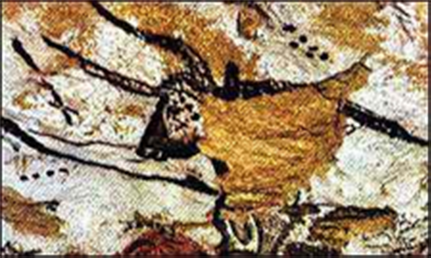
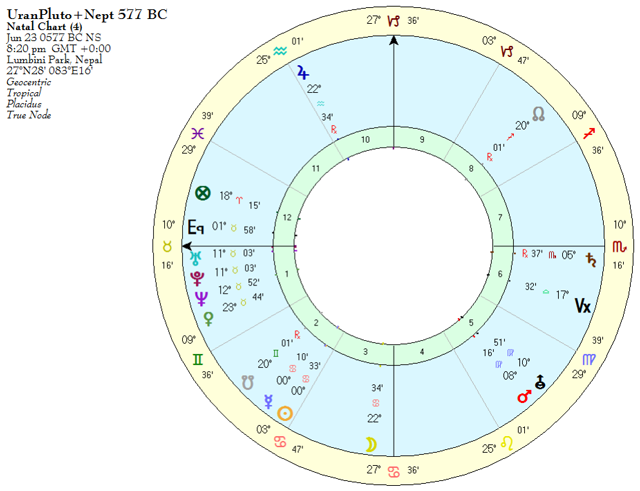
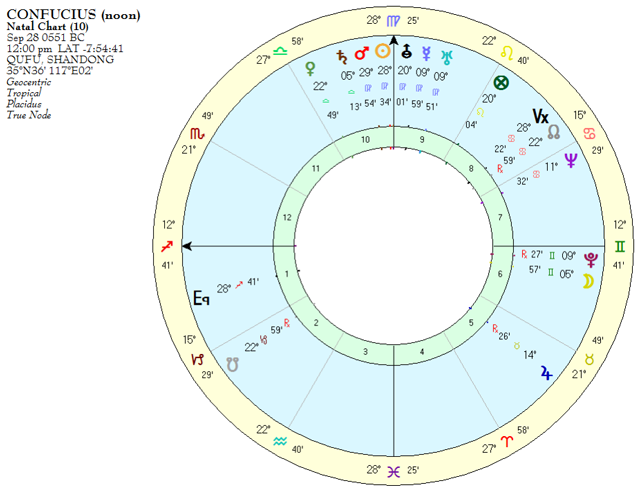
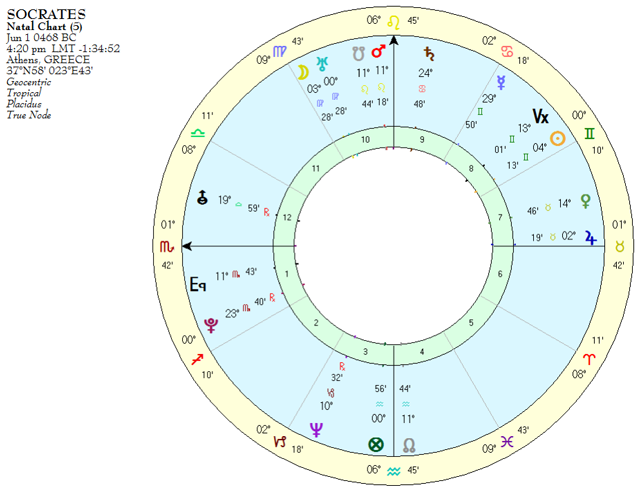
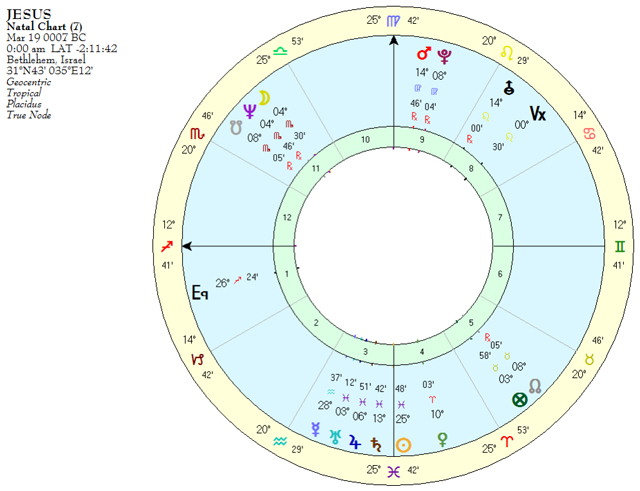
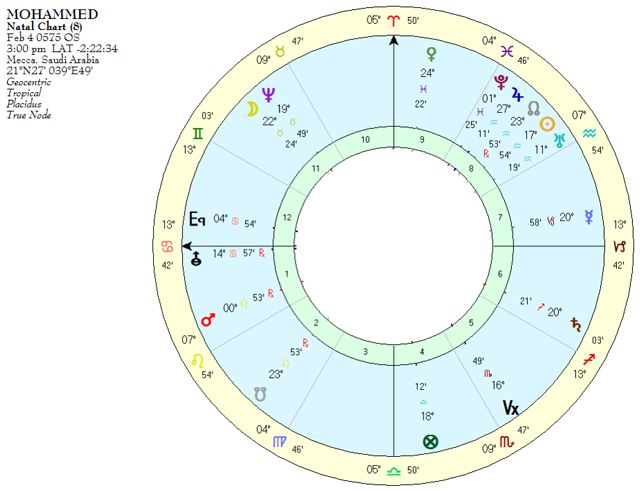

I think this is the most important article I ever wrote. Thank you Peter! I’m looking forward to seeing the chart of Buddha added…